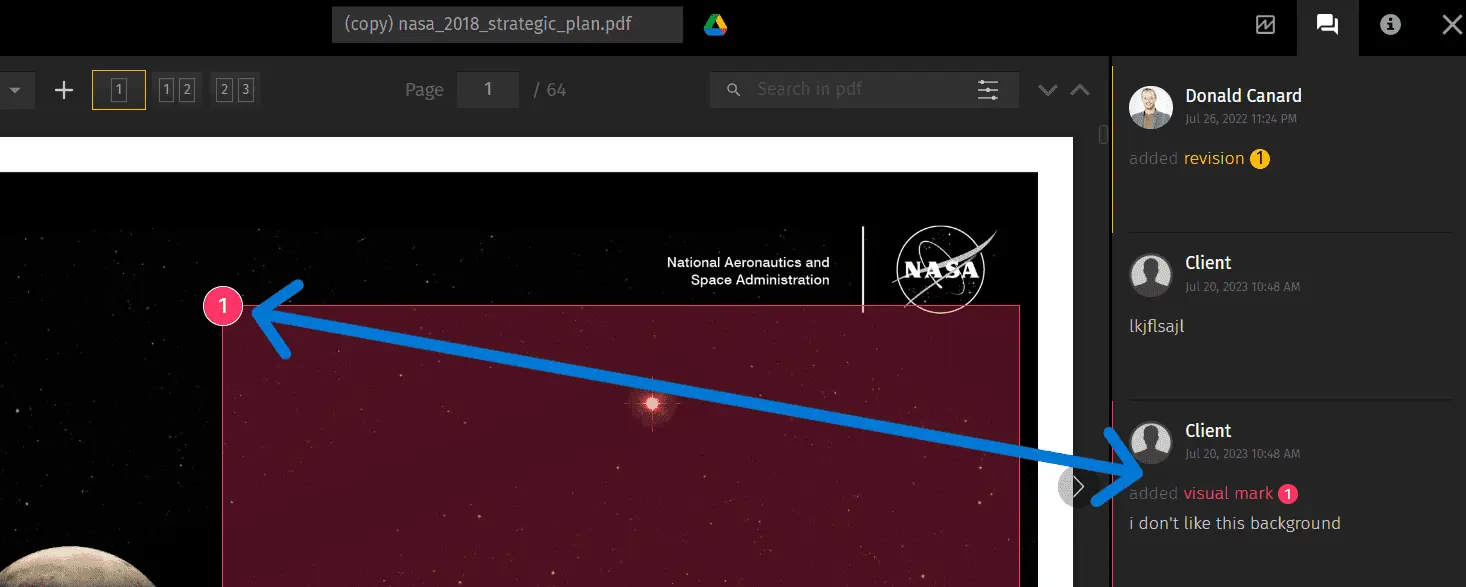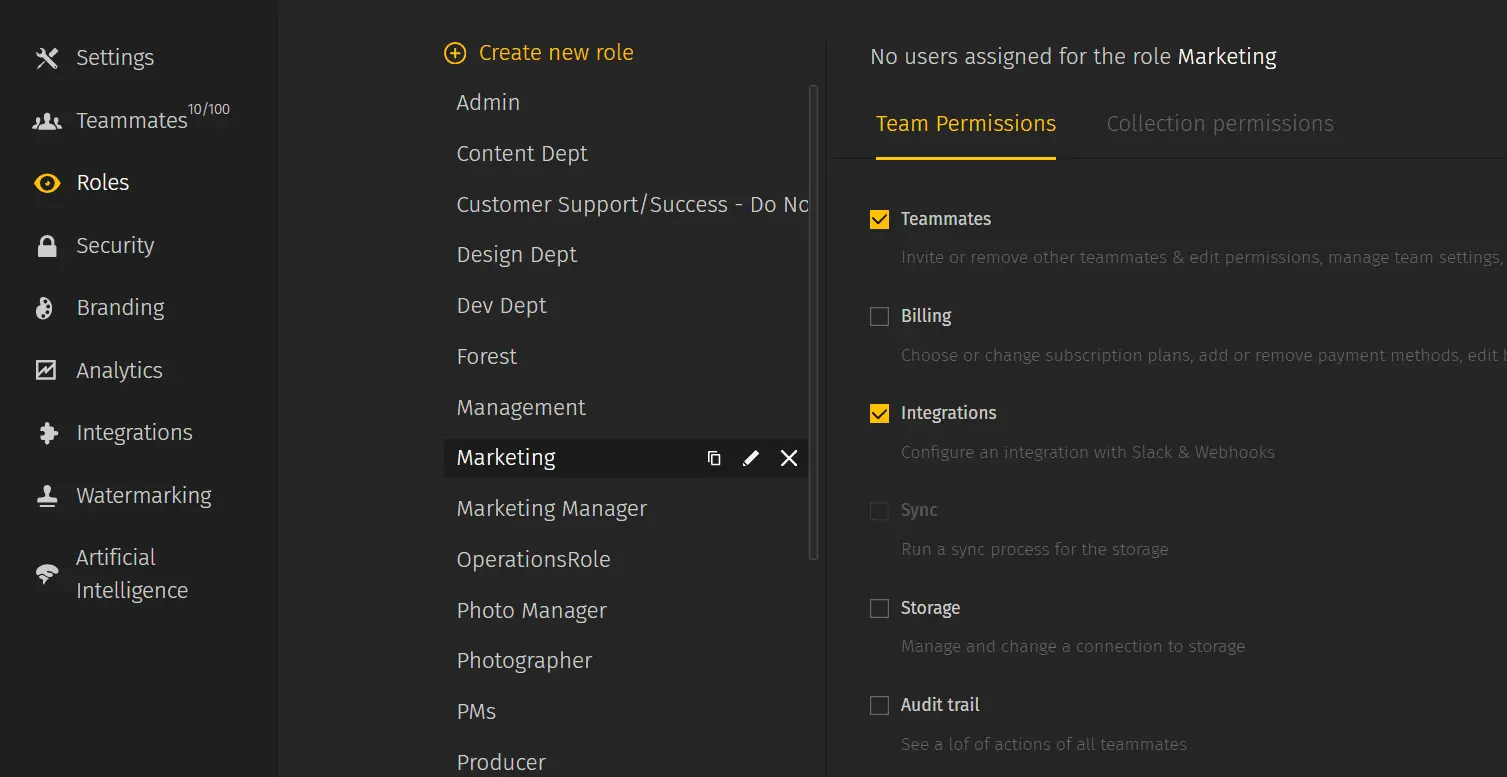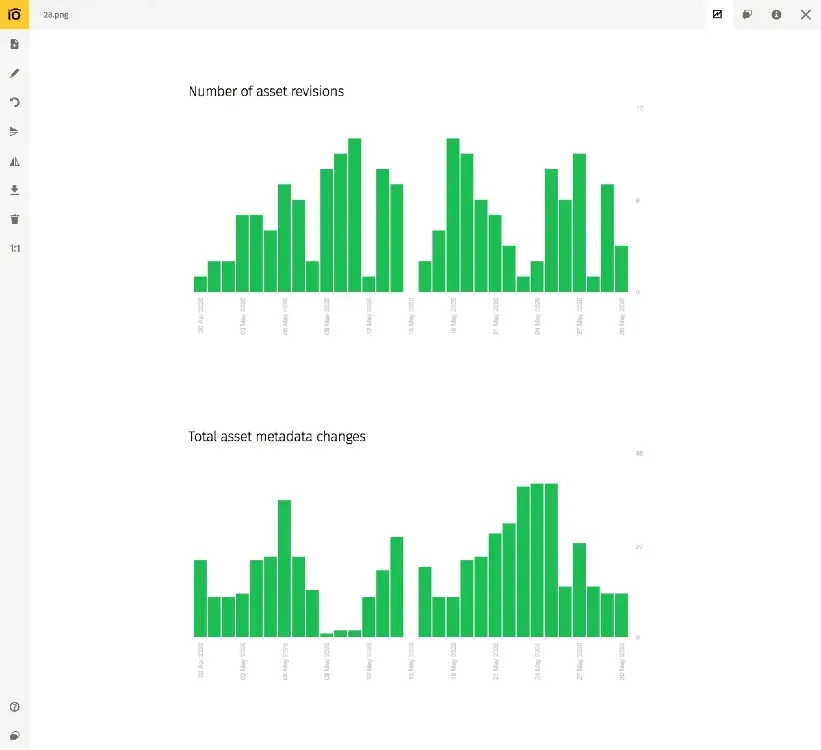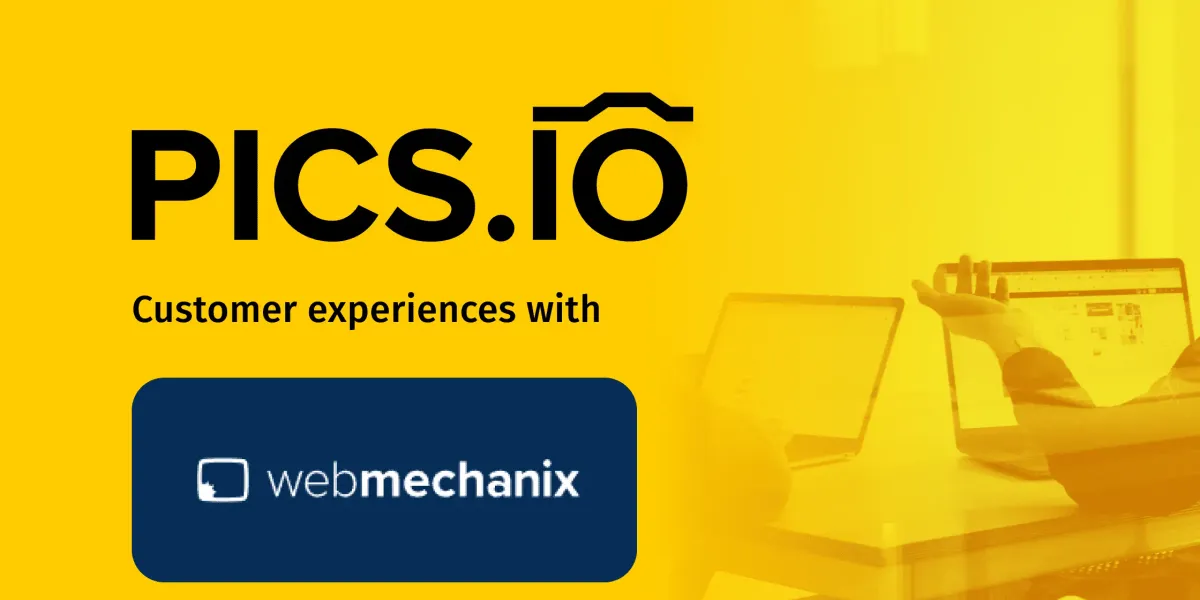In this article, you’ll learn:
When it comes to managing your company’s digital content, do you need a digital asset management vs document management system? The choice hinges on whether you’re predominantly handling multimedia assets or text-heavy documents. Digital Asset Management (DAM) specializes in managing, enhancing, and sharing rich media assets like photos and videos, focusing on creative content and branding. In contrast, Document Management Systems (DMS) are designed for organizing, storing, and tracking text-based documents, emphasizing efficient document retrieval and record-keeping.
Avoid the confusion with this clear-cut comparison that zeroes in on the niche strengths of DAM and DMS. Beneath the jargon, find out which system best suits your business’s specific needs, as we concisely chart their functionalities and real-world applications.
Understanding Digital Asset Management (DAM)
This hub is designed to keep your photos, videos, audio recordings, documents, and other files safe and organized, making it easier to handle all your media files in one place. DAM systems take traditional file storage to the next level and provide better ways to organize files, manage metadata, and search for assets.
Key Features and Benefits of Digital Asset Management
Let's have a look at what a digital asset management platform has to offer on the example of Pics.io DAM software:
- Cloud Storage for Multiple File Formats
Pics.io is a centralized repository for a wide array of file formats. Unlike traditional storage solutions, DAMs aren't limited to basic document types. They can store, manage, and share everything from high-resolution images and videos to complex 3D models and audio files. This versatility is essential for businesses dealing with diverse digital assets.
Pics.io works on top of Google Drive or Amazon S3, so that you don't need to move your media assets anywhere.
- Version Control
Version Control in DAM ensures that the latest version of any digital asset is readily available, while also preserving previous versions. This feature is crucial for tracking changes over time and for collaboration on digital projects. With Pics.io, you can even mark specific areas on images, make time-stamped comments on videos, and tag other users in these comments. All these tools are extremely helpful when different teams are working on multiple file versions

- Metadata and Advanced Search Capabilities
DAMs are famous for their advanced metadata - it helps to tag, organize, and search digital assets with detailed information like author, creation date, format, and rights information. Additionally, you can create your own custom fields that will work for your company/organization. A well-developed metadata schema improves the searchability of digital files and decreases search time.
- User Permissions
These ensure the right people have the right access to creative assets. This feature allows administrators to set different access levels for users based on their roles or responsibilities within the organization. By doing so, sensitive information in DAM is only accessible to authorized personnel, thereby reducing the risk of data breaches or misuse of digital content.

- Easy File Sharing and Receiving
DAMs simplify distributing and obtaining digital assets both internally and externally. Users can easily share files with team members, clients, or stakeholders through secure links or dedicated portals. Websites are for sharing files, while inboxes are for receiving files. In both cases, all the assets are stored or will end up in your DAM, so you can forget about endless emails with files.
- AI Tools
AI in DAM leverages artificial intelligence to automate and optimize tasks such as face recognition and tag suggestion. These tools can significantly reduce manual effort in categorizing, organizing, and asset retrieval.
- Reports and Analytics + Audit Trails
With these features, one can receive comprehensive data on how digital assets are used and managed within the organization. Analytics provides insights into assets usage/changes, while audit trails show who did what in the DAM system, which helps with tracking changes made to assets and users' activities.

- Mobile App
DAM users have quick access to their digital assets even when they are on the go. A dedicated mobile application allows for remote access, uploading, editing, and sharing of digital assets directly from a smartphone or tablet. This mobility enhances the flexibility and responsiveness of teams, especially in dynamic work environments.
- Inbuilt Editing Tools
Digital asset management often provides a convenient and efficient way for users to edit videos and images directly within the system. These tools range from basic editing functions like cropping and resizing to more advanced features like color correction and filter application. Moreover, one can also choose the necessary image format and size for different social media (LinkedIn vs YouTube vs Instagram) and immediately download it. With such functionality, there's no need for separate editing software, which increases productivity.

- Integrations
If you do need additional software to work with your DAM, just use integrations. Connecting digital asset management with other software and tools allows for a more unified workflow, as DAM can integrate with tools like CRM systems (WordPress), marketing platforms, project management tools (Jira), etc. The ease of integration enhances the overall effectiveness of managing digital assets across various business functions.
When to Use DAM
Here are the 2 most common reasons:
- Large Volume of Digital Assets: Organizations with a significant amount of digital content (images, videos, documents) need DAM for efficient management and retrieval.
- Collaborative Creative Processes: When multiple teams or individuals (especially those working remotely or internationally) are involved in creating, editing, and using digital assets, DAM streamlines the workflow and consistency.
Digital Asset Management (DAM) systems play a crucial role across various industries, and here are some key use cases:
Marketing and Brand Management: For marketing teams, DAM is invaluable in managing an extensive collection of brand assets, including logos, marketing collateral, and campaign materials. It helps to maintain brand consistency across all channels and simplifies the process of updating marketing materials.
Here's our article on how digital marketing agency WebMechanix benefits from using Pics.io DAM.

Media Libraries and Archives: Media organizations and libraries use DAM to store, catalog, and retrieve vast amounts of digital content such as photos, videos, and audio files. It supports effective archival processes and quick content retrieval for media production and distribution.
Creative Agencies and Design Firms: DAM systems are essential for creative agencies and design firms in managing project files, design assets, and client presentations. They facilitate collaboration on creative projects and maintain version control for design files.
Educational Institutions and E-Learning: In the education sector, DAM aids in managing digital educational materials, such as e-books, instructional videos, and online courseware. It simplifies the distribution of educational content to students and faculty.
Corporate Communication and Documentation: Corporations leverage DAM for managing internal communication materials, training videos, and corporate documentation.
Nonprofits: These organizations often operate with limited resources and a need for high efficiency. DAM enables nonprofits to effectively organize, store, and share a wide range of digital assets like promotional materials, donor information, and educational content. DAM facilitates streamlined collaboration among volunteers and staff, often spread across various locations, enhancing their outreach and fundraising campaigns. By centralizing their digital resources, nonprofits can focus more on their mission-critical activities.
Read more on how nonprofit organization Collage Dance manages its videos and images with Pics.io digital asset management here.
Governmental Institutions: DAM systems in these institutions play a key role in organizing, preserving, and distributing public information and records. They support transparency by providing controlled access to digital resources like legal documents, policy papers, and public service information. Additionally, DAM aids in complying with various regulatory standards and archival requirements.
Understanding Document Management System (DMS)
A DMS, in turn, makes it easy to manage text-based documents, store and find them, while enhancing collaboration and productivity.
Key Features and Benefits of Document Management Systems
- Cloud Flexible Storage for Documents
Cloud-based storage in DMS brings to the table scalable, secure, and accessible storage solutions. It allows businesses to store vast amounts of different documents without the need for physical space. Moreover, all the data is backed up and protected from loss or damage.
- File Sharing
DMS facilitates easy and secure distribution of documents. It supports collaboration by allowing users to share documents with colleagues and external parties via live links, maintaining control over who can view or edit text documents.
- Advanced Search
DMS has multiple search filters like date, document type, author, tags, etc. With full-text search, users can also search the entire document text instead of metadata only.
- Mobile-Friendly
The mobile-friendly nature of modern DMS allows users to access, edit, and manage documents from anywhere, using mobile devices. This feature is essential for businesses with remote teams or those who need to work on the go.
- User Permissions
This feature in DMS helps in maintaining document security. Administrators can set different access levels for users, depending on their roles in an organization.
- Compliance
DMS aids in compliance with various regulatory requirements (like HIPAA, SEC, and GDPR) as documents are stored, managed, and disposed of in a manner that meets legal standards. Compliance tools also take care of all compliance-related tasks such as updating documents, sending reminders about deadlines, and generating reports. This feature works wonders in reducing human errors and making compliance tasks more effective. It is essential for industries with strict regulatory guidelines (law, accounting, etc.).
- Version History/Audit Trails
These are vital for tracking changes made to documents. They provide a chronological record of edits, access, and actions taken on each document, crucial for security and accountability.
- Native Editing Tools
Native editing tools in DMS allow users to create, edit, and format document automation within the system. There's no need for external editing software.
- Document Templates
Available templates make the creation of standard documents faster and easier. What's more, it ensures consistency and saves time for employees. Templates can be customized to suit various business needs and preferences.
- Integrations
Popular integrations for DMS include CRM systems, project management tools, and email platforms. These integrations create a more unified and efficient workflow and simplify daily tasks as connected digital tools can do different tasks much faster.
- Document Linking
This feature ties everything together, facilitating easy access to documents dispersed throughout the digital library. It often happens that using one document is impossible without using another one (such as work contracts, different agreements, etc.). So, linking them together saves time on looking for the necessary papers every time.
- Collaborative Tools
This involves various tools and functionalities that allow multiple users to work on the same document simultaneously. Features like real-time editing, commenting, task assignments, and shared workspaces are integral parts of DMS. These tools enable teams to coordinate effectively, regardless of their physical location.
When to Use Document Management Systems
These versatile tools cater to various organizational needs for managing digital documents efficiently and securely. Here are some factors that might mean that your company needs a DMS.
- High Volume of Documents: Organizations dealing with large volumes of documents need a DMS for usable storage, retrieval, and management.
- Need for Regulatory Compliance: Industries requiring adherence to strict data management and privacy regulations benefit greatly from DMS.
- Collaborative Work Environments: Teams that collaborate on documents across different locations use DMS to streamline their workflows and communication.
- Requirement for Secure Document Storage and Access, as well as Archivaland : Any organization prioritizing the security of their documents, including controlling access and maintaining audit trails, needs a DMS.
Industries where document management systems are most popular:
- Healthcare: For managing patient records, compliance documentation, and research papers while adhering to privacy standards.
- Legal Sector: Law firms and legal departments use DMS for organizing case files, contracts, and legal research.
- Financial Services: Banks and financial institutions rely on DMS for managing client records, transaction documents, and regulatory compliance paperwork.
- Education: Educational institutions utilize DMS for administrative documents, academic records, and e-learning materials.
- Government: For managing public records, policy documents, and inter-departmental communication.
Differences between DAM and DMS
The key differences between DAM and DMS lie in their respective strengths: DAM shines with features like organizing, searching, downloading, and sharing digital assets, while DMS takes the cake for business document input, indexing, search, processing, and workflow automation. Think of it this way: DAM is your go-to for creating content, aiding sales, and maintaining brand consistency, while DMS is your trusty sidekick for handling loads of documents and sharing information outside the company.
Here's a more detailed explanation of the major differences between these 2 software tools.
File Types Supported
- DAM: Primarily designed to handle a wide variety of digital media files including images, videos, audio files, and multimedia presentations. It's well-suited for creative and marketing assets.
- DMS: Focused on managing documents such as text files, PDFs, and spreadsheets. It's ideal for standard office documents and records.
Primary Functions and Usage
- DAM: Used for storing, organizing, and sharing digital media. It often includes features like advanced search capabilities, version control, and rights management, catering to creative workflows.
- DMS: Geared towards document storage, retrieval, archiving, and tracking. It often includes features like workflow automation, compliance tracking, and document collaboration.
Accessibility and Distribution
- DAM: Geared towards making digital assets readily available for use and distribution across various platforms and channels.
- DMS: Prioritizes secure access and sharing of documents within or across organizational boundaries, with a strong emphasis on data security and compliance.
User Interface and Experience
- DAM: Typically offers a more visual interface with thumbnail previews, making it easier to browse through large volumes of multimedia assets.
- DMS: Often has a more traditional file-and-folder structure, focusing on document organization, accessibility, and security.
Integrations with Other Tools
- DAM: Integrates with creative software, marketing tools, and content management systems, catering to a media-rich workflow.
- DMS: More likely to integrate with office productivity tools, email clients, and enterprise resource planning (ERPNext systems) , aligning with document-centric operations.
DAM vs DMS: What to Choose
Now that we’ve explored both Digital Asset Management (DAM) and Document Management Systems (DMS) in detail, it’s clear that they cater to different business needs. If your organization extensively uses rich media files like photos, videos, and audio files, a DAM would be the right fit. On the other hand, if you primarily handle textual business documents and require an efficient system for storage, organization, and collaboration, a DMS would be more suitable.
However, the decision between DAM and DMS is not universally applicable. Businesses must assess their specific needs and select the system that most effectively satisfies them. Some of the factors to consider include file formats supported, user interface, integrations, security controls, metadata tagging, and storage capabilities.
Did you enjoy this article? Give Pics.io a try — or book a demo with us, and we'll be happy to answer any of your questions.





